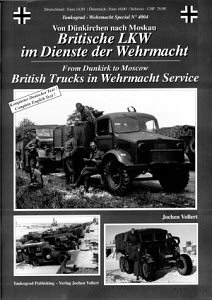

 British
Trucks in Wehrmacht Service - From Dunkirk to Moscow
British
Trucks in Wehrmacht Service - From Dunkirk to Moscow
By Jochen Vollert
Tankograd Wehrmacht Special No 4004.
Soft cover, A4 size, 64 pages
Review by Peter Brown
This was not haphazard use of what was available locally as vehicles were collected, sorted, repaired and issued for use to all the German armed services. Many were used with just a coat of paint and some did not even get that, while many were fitted with Notek night-driving lights and some open vehicles were fitted with cabs. In a few cases more complicated conversions were carried out for specific roles. Some vehicles remained with units on occupation duties in France but the greater part was used with the German forces in their Russian campaign. One in five of the one million vehicles initially sent Eastwards was a captured French or British type. Despite the harsh conditions and lack of spare parts they were used in a variety of roles though their numbers steadily dwindled. A few were still around as late as the final year of the war.
This book shows them in service. A short introductory chapter covers the background to their use with photos of various trucks abandoned in 1940 and collection dumps, then we have a photo study of them type by type. Coverage starts with various cars, then sections on various types of Morris Commercial and notably different Bedfords as these were the most numerous marque in BEF use and logically became the most common type in German service. Shorter sections cover the less widely used types from a who-was-who of British truck manufacturers of the era from the smaller Albions to heavy AEC Matadors and big.
Photo sources or visible markings does allow units or at least the type of unit can be identified some cases but even if these are not known this does not detract from the book. This selection of clear, well-printed photos gives us both a different view of British trucks and lorries of this period and another viewpoint of German equipment. In either form it will be a source of nostalgia and modelling inspiration. Softskins are not as less well covered in model form as armour, but several of the types shown here are available although in many cases only as resin kits. At least we now have alternative finishes for them.
Well produced as would be expected from Tankograd, this one is a personal favourite and comes recommended. Available from Tankograd Militarfahrzeug distributors. For more details contact the publishers Verlag Jochen Vollert on jochenvollert@tankograd.com My thanks to Justin Gainham at Bookworld for the review copy.
Page created 2 July 2005